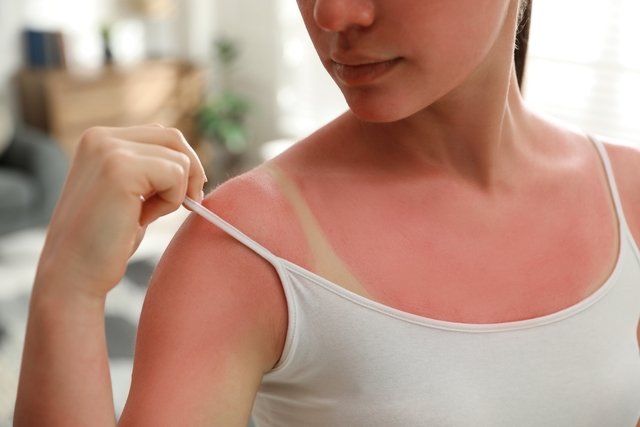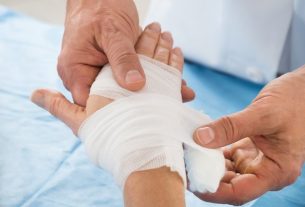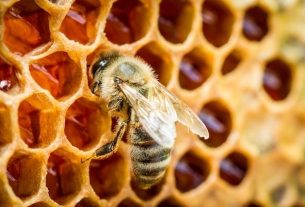A 1st degree burn is a more superficial type of burn as it affects the outermost layer of skin, the epidermis, causing symptoms such as redness, swelling, increased sensitivity to touch or pain in the affected skin.
This type of burn is most often caused by prolonged exposure to the sun, but can also occur due to contact with hot objects or surfaces, exposure to hot water, hot oil or steam.
In most cases, 1st degree burns can be treated at home by applying cold compresses, using painkillers and burn ointments. However, if it causes very intense pain, affects large areas of the body or occurs in children or the elderly, it is recommended to go to the emergency room immediately.

How to recognize 1st degree burn
The main characteristics that help to recognize a 1st degree burn are:
- Redness of the skin, in the case of lighter skin;
- Reddish-brown skin in the case of skin with a darker phototype;
- Swelling and heat in the affected skin;
- Pain in the area, for 2 to 3 days;
- Increased skin sensitivity to touch;
- Itchy skin;
- Peeling of the skin, usually 1 or 2 days after the accident.
This type of burn, as it only affects the epidermis, which is the outermost and superficial layer of the skin, does not cause the appearance of blisters, as occurs in 2nd degree burns.
Don’t ignore your symptoms!
What is the healing time?
The healing time for a 1st degree burn generally varies between 2 to 5 days, but it may take longer if it has affected larger areas of the body or if you have 2nd or 3rd degree burns at the same time.
A 1st degree burn does not leave spots or scars on the skin after healing.
What can cause 1st degree burn
1st degree burns can be caused by prolonged exposure to the sun, hot water vapor, contact with scalding liquids such as hot water or oil, contact with fire or hot objects and surfaces.
Furthermore, 1st degree burns can also occur due to chemical burns caused by contact with gasoline, acids or caustic soda, for example. See other causes of chemical burns and what to do.
First aid for 1st degree burn
First aid for a 1st degree burn includes:
- Remove clothing and other objects that are near or in the area of the burnsuch as bracelets, watches or rings, for example.
- Immediately cool the skin by leaving it under cold running waterwith a gentle jet, for at least 20 minutes.
- Take a cold showerif the burn occurred on large areas of the body;
- Place a towel soaked in cold water over your faceif the burn was on the face;
- Cover the affected area with a sterile dressing or a clean cloth dipped in saline solution or cold water;
- Wash the affected area gently with neutral soap.
If the 1st degree burn is causing a lot of discomfort or pain, has affected large areas of the body, you should go to the hospital as soon as possible to receive the most appropriate treatment.
When to go to the doctor
It is important to go to the emergency room if the burn has affected large areas of the body or is larger than the size of the palm of one hand.
In the case of babies, children or the elderly, regardless of the size of the burn or the intensity of the symptoms, you should always go to the emergency room.
Likewise, whenever there is a burn caused by electricity or chemicals, you should go to the emergency room.
Furthermore, if the burn occurred on the face, eyes, neck, palms of the hands, soles of the feet, wrist, buttocks or knees, it is important to go to the emergency room immediately.
How the treatment is carried out
Treatment of 1st degree burns can almost always be done at home, with measures such as:
- Applying cold compresses to the areafor about 15 minutes, several times a day;
- Take analgesicssuch as paracetamol or ibuprofen, recommended by your doctor, to relieve pain and discomfort;
- Increase water intake or offering breast milk or formula in the case of babies, to avoid dehydration;
- Apply a home remedy for burnssuch as aloe vera gel or honey;
- Protect affected skin from the sunapplying sunscreen and using clothing or a hat to cover the affected area.
Additionally, the doctor may recommend the use of burn ointments to help alleviate symptoms and speed up healing. See the main ointments for burns.
What not to do
It is important not to put very cold water or ice on the burn site, as this can worsen the skin injury.
Furthermore, you should not apply oil, oily ointments, butter, olive oil, alcohol, sugar, coffee grounds, toothpaste or any other substance to the burn.
Bibliography
- MINISTRY OF HEALTH. Manual for emergency treatment of burns. 2012. Available at: <https://bvsms.saude.gov.br/bvs/publicacoes/cartilha_tratamento_emergencia_queimaduras.pdf>. Accessed on 20 Sep 2023
- LANDSLEITNER, B.; KEIL, J. Burns and scalds in children. Med Klin Intensivmed Notfmed. 110.5; 346-53, 2015
- WRIGHT, E. H.; et al. Cooling of burns: Mechanisms and models. Burns. 41. 5; 882-9, 2015
- AMERICAN ACADEMY OF DERMATOLOGY ASSOCIATION. How to Treat a First-Degree, Minor Burn. 2023. Disponível em: <https://www.aad.org/public/everyday-care/injured-skin/burns/treat-minor-burns>. Acesso em 20 set 2023
- SCHAEFER, T. J.; SZYMANSKI, K. D. IN: STATPEARLS (INTERNET). TREASURE ISLAND (FL): STATPEARLS PUBLISHING. Burn Evaluation and Management. 2023. Available at: <https://www.ncbi.nlm.nih.gov/books/NBK430741/>. Accessed on 20 Sep 2023
- JESCHKE, M. G.; HERNDON, D. N. Burns in children: standard and new treatments. Lancet. 383. 9923; 1168-78, 2014
- PENCLE, F. J.; MOWERY, M. L.; ZULFIQAR, H. IN: STATPEARLS (INTERNET). TREASURE ISLAND (FL): STATPEARLS PUBLISHING. First Degree Burn. 2023. Available at: <https://www.ncbi.nlm.nih.gov/books/NBK442021/>. Accessed on 20 Sep 2023
- MONIRUZZAMAN, M.; et al. Pediatric First-Degree Burn Management With Honey and 1% Silver Sulfadiazine (Ag-SD): Comparison and Contrast. Cureus. 14. 12; e32842, 2022




